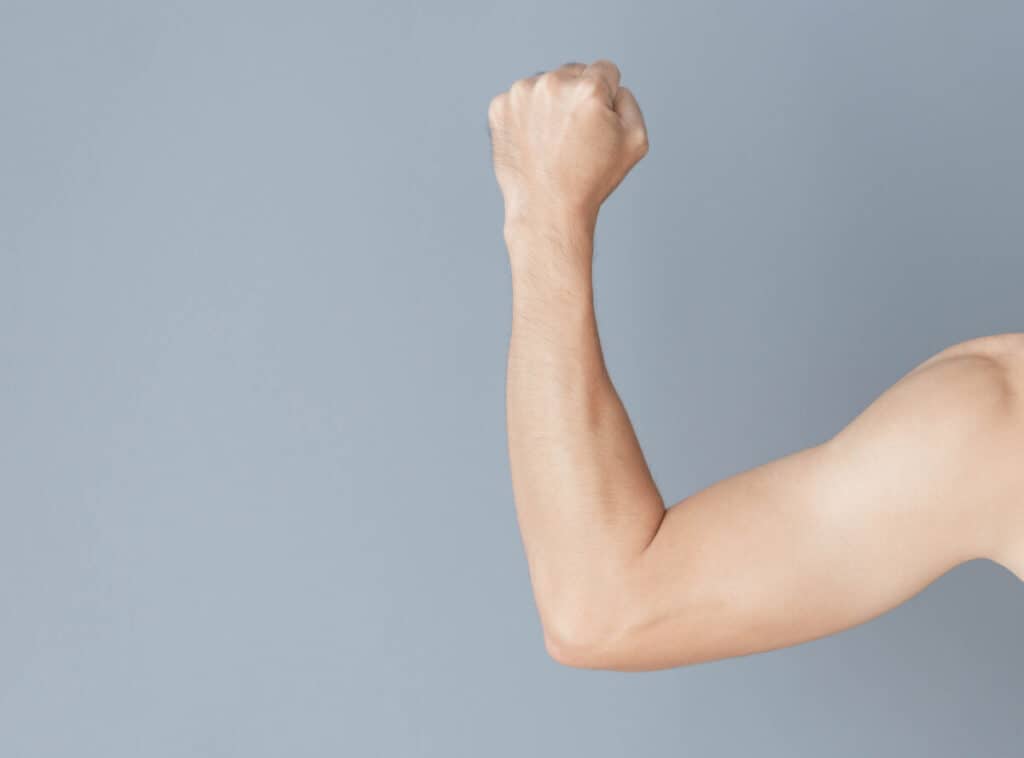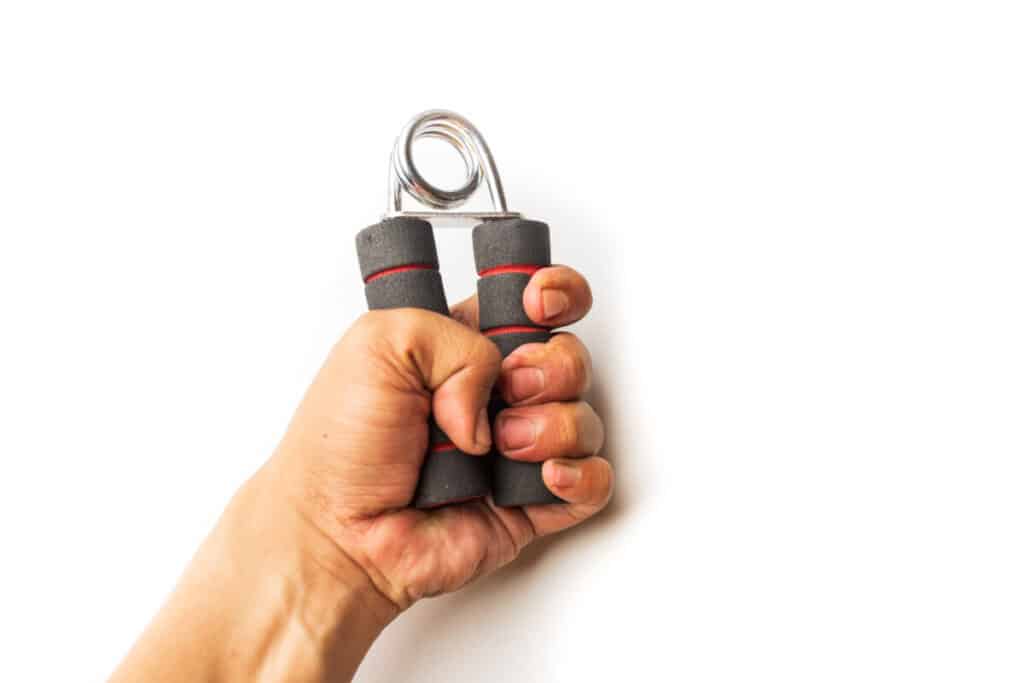
As small as it seems, grip strength is an important aspect of fitness. It’s often overlooked until it starts to hinder progress toward other strength or performance goals.
Grip strength is poor when the muscles in the hand and forearm aren’t properly conditioned. Incorporating grip exercises will target the hands and forearms so grip strength can be improved. Adapting a current workout plan to target the hands and forearms will also improve grip strength.
Below are listed twelve exercises to increase grip strength. Add these to your workout plan to improve your grip and strengthen your forearms.
Why Are My Grip Muscles so Weak?
When building a workout plan, people tend to focus on bulking up and getting stronger, but often grip gets overlooked. When people think of starting to exercise, some of the main focuses go on the abs, biceps, quadriceps, or other noticeable or functionally important muscles and muscle groups. When the forearms or fingers are forgotten, your grip starts to fall behind the rest of the body. This can hinder progress toward other goals, such as deadlifting heavier weights.
Grip is an underrated aspect of exercise and strength. Improving your grip can aid in daily life and improve other areas of working out. Grip is crucial to some sports and hobbies, such as rock climbing or powerlifting. While you may not need outstanding grip strength for your fitness goals, it’s important to keep your grip strength in balance with the rest of your body.
1. Finger Resistor Bands
On Amazon, you can purchase a finger resistor band. There are a few different styles, but this set comes highly recommended. It comes with three levels of resistance and is designed to improve grip strength for rock climbers. The different resistance bands make it easy to tailor it to your current strength level. Using these resistor bands will gently work your forearms and help you exercise the muscles on the back of your hands. These bands are great because they can easily slide into your daily routine and don’t take up much time or room.
Start with the lowest resistance band and work your way up to the highest. Set a number of reps to complete on each side or a time limit for each side. Slowly extend and spread your fingers out, hold for a second, then retract them slowly. Perform as many sets during the day as you want or need.
2. Grip Strengthener

Similar to the resistor bands, you can use a grip strengthener tool like this one. There are other variations of this type of grip strengthener, but this one allows for six levels of intensity. This targets the muscles on the inside of your hand and works the forearms.
Start with the lowest level of intensity and work your way up to the highest level. Set a number of reps to complete or a time limit for each side. Slowly compress the grip strengthener, hold for a second, then slowly release.
There are other types of grip strengtheners you might want to consider. This one targets the individual fingers so you make sure you are developing finger strength evenly.
3. Wrist Curl
A wrist curl will help you work your forearms and improve your wrist mobility and strength. It’s really easy to add to a current workout plan, and it won’t take too much of your time.
Choose a free weight that is not too heavy that will still give you a challenge. If you’re not sure where to start, try 5 or 10 lb. dumbbells. With wrist curls, you don’t want to start off too heavy; the workout is best when you focus on more reps rather than increasing weight.
Sit on a bench and lean forward, keeping your back straight. Place your forearms on your thighs with your hands hanging off beyond the knee. Grab your dumbbell underhand, so your palms are facing the ceiling, then curl with just your wrists. Try to reach your full range of motion with your wrists, bending them up and down. Start with completing 10 to 15 reps, but listen to your body and adjust weight and reps accordingly.
For an increased workout, allow the weight to roll to the tip of your fingers, then curl your hand back into a fist shape. This will increase the workout to include your fingers and hand strength as well as forearms and wrists.
4. Zottman’s Curl
The Zottman’s curl will work your biceps in addition to targeting muscles in the forearm. This exercise is frequently used to bulk up the arms. You could alternate regular curls with Zottman’s curls in your current workout plan, or you could add these in to get the upper and lower arm benefits in addition to your regular bicep curls. When choosing a weight and number of reps for the Zottman’s curl, start with something similar to what you already use for your regular bicep curls, then adjust as needed.
The Zottman’s curl starts with the same principles as a regular curl. Stand with your back straight and grip the weights in either hand at your sides. Bend at the elbow, bringing your hands up with your thumb facing the ceiling. As you curl, turn your hands, palms up, to the regular curl position. As you lower the weights, twist your hands, so they are now palms down.
5. Deadlift with Pauses

A deadlift utilizes your grip muscles already. Grip strength is required for a deadlift, so it also helps you improve your grip strength. If you are already completing a deadlift in your workout routine, you can add a pause at the top of the lift to improve the grip muscles.
6. Farmer Walks
A farmer walk can work a lot of functional muscles and improve strength and endurance in many areas, but it also improves grip strength.
Choose a dumbbell or other heavy object to lift and carry, then walk in a straight line for a set distance or time. Be sure to lift and set down your weight with proper form to keep your body safe from injury.
7. Dead Hang
One of the most popular ways to build grip strength among climbers is the dead hang. It will build grip strength, first of all, but it will also help you improve the rest of your arm and back muscles.
The dead hang is exactly what it sounds like. Grab onto a pullup bar and let your body hang. This exercise is great for the end of a workout routine. If performed at the completion of a workout, grip onto the bar and hang as long as you can. To increase the difficulty, use a hangboard. Climbing gyms typically have hangboards available for use, but you can also purchase a hangboard that you can attach to a regular pullup bar.
8. Plate Pinch
The plate pinch is an easy exercise to complete in a gym where weights are accessible. This exercise works your forearms and hands.
Grab some weight plates that are challenging to grip in your hands and hold them at your sides, maintaining good posture. You can grip the weights at your sides for a length of time or you can add some variation.
To increase movement in the exercise, you can grab the plate in one hand and switch it back and forth between each hand. You can twist your hands to face front, then back to increase range of motion. You can add additional plates so the weight is increased and you have to grip tighter to hold the plates together.
Another variation that will work your upper arms, shoulders, and back as well is to lift the plates. You will need a lighter set of weights to complete this exercise. Start holding the plates with your palms facing your thighs. Lift your arms straight out to parallel with the floor, then slowly release them back down to your sides. Complete as many reps as you deem necessary. If you aren’t sure where to start, choose a lighter weight and try 10 reps. Adjust from there.
You can also complete the farmer walk using the plate pinch technique to get the benefits of both.
9. Towel Pullup
This exercise, while similar to a pullup, targets a different set of muscles. The towel pullup will help you increase grip strength while also working other muscles in your arms, back, and abs.
Drape two towels over the pullup bar and grip onto each with either hand. Lift yourself up as far as you can, just as you would for a regular pullup. You may also use one towel and grip either side. Start with just a few reps, but increase reps as your body adjusts to the exercise.
10. Reverse Curl
A reverse curl will work your forearms and hands, as well as your back, shoulders, and upper arms.
A reverse curl works the same way as a regular bicep curl, except that your palms are facing down. Weight choice and rep amounts will likely need to be lighter or fewer than your regular curl routine. Once you feel comfortable with the exercise, you can adjust your weights as needed.
11. Reverse Pushup
A reverse pushup will improve your forearm strength and get your body used to unique arm positions that will increase your forearm and grip ability.
For a reverse pushup, align your body as you would for a regular pushup, then twist your hands out and around to point your fingers toward your feet. These are more difficult than regular pushups, so start off gently with fewer pushups, but work up to more reps.
12. Fingertip Pushups
Fingertip pushups are a great addition to a grip strength workout. They will work your forearms, hands, and fingers. This is a great exercise to work on your individual finger strength, but it is quite advanced.
Set up as you would for a regular pushup, then spread your fingers and lift yourself onto them. These will be much more difficult than regular pushups, so start with small reps. You can complete more sets of small reps to increase the workout effect.
Incorporate Grip into Your Established Workout Plan
Personal trainer, Kaneasha Meindl, of Meind and Muscle, suggests that the best method of improving grip strength is to incorporate grip strengthening practices into your current workout routine. Instead of frequently using light weights or machines, she suggests using heavy free weights.
Grip strength is required to lift heavy free weights, so you will naturally increase your grip strength as you lift heavier free weights. Adding variety to your workouts will also improve your grip strength. To increase the effects of the grip workout, focus on gripping longer. The example above of the deadlift with a pause can be carried over into other exercises. The pause makes your hands and forearms work for an extra period of time, thus improving your grip strength. In addition to improving grip strength, pauses also help to improve endurance.
Some of the exercises above also work other parts of the body but still focus on the hands and forearms. These are great replacements or trade-off exercises to add to your routine. For example, the Zottman’s curl maintains the muscle workout for the upper arm, shoulders, and back but adds the forearm element.
If you are looking into a sport or hobby that requires exceptional grip strength, you will want to spend some time on focused grip strength exercises. If you aren’t looking for grip strength for any specific reason, adapting your current workout plan to include more grip focus may be adequate for your fitness goals.
Stretching Your Hands and Forearms
As with any muscle, stretching should be combined with strength training so you can maintain flexibility and a good range of motion. Before you work your grip muscles, gently stretch or shake your hands out to warm them up and prepare them for the work. After you complete an exercise, be sure to stretch your hands and arms well.

Grip Muscles Stretches:
Press your palms together and flatten your fingers together. Press your hands together and down to stretch the front of the wrists and your forearms. You may also stretch your hands one at a time by pulling your fingers and palm back, one hand at a time.
Stretch the back of your wrists by pushing on the back of your hand so your wrist bends forward.
Extend your fingers fully and hold them for a few seconds. Then contract your hands into fists. Repeat a few times. You may also stretch your fingers out individually by pushing or pulling on them one by one.
Rotate your wrists in circles. Continue to circle for several seconds, then switch directions and continue for an equal amount of time. This will keep your joints loose and increase range of motion and flexibility.


